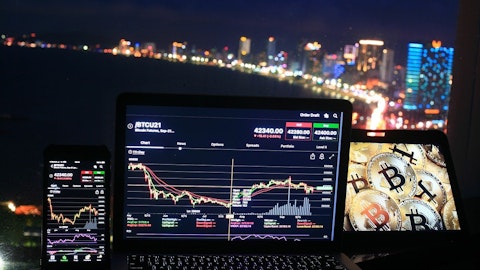Daniel Fannon: Thanks, good morning. You mentioned several times the ETF market maker being increased in activity. Can you disclose what percentage of volume they have historically been for you? And then more broadly, are you seeing other parts of the market or other participants starting to pick up in terms of activity as well? You’ve mentioned volatility, you’ve mentioned ETF market makers, but I was curious about the breadth of activity beyond those — or more specifics around that?
Chris Concannon: Sure, Dan. First, our ETF market makers make up about 20% to 25% of that volume. More importantly, we’ve certainly seen systematic hedge funds that have been during the credit market pickup in activity across both high grade and high yield, but particularly large presence in the U.S. credit market. The overall activity, while volumes are slightly up, the overall activity is across all shapes and sizes of firms, both large investment managers as well as ETF market makers and the hedge fund community. So we are seeing a pickup across all firms. We continue to see portfolio trading used as a solution across our largest clients. We’re seeing more and more international clients using portfolio trading solutions as well.
So again, multiprotocol selection is definitely the theme. The other theme that’s critically important is our clients are not adding traders. They are consistently asking us to deliver technology solutions that solves workflow efficiencies for them, because they are not adding traders. And so all of it if you look at the theme of what we’re rolling out from a technology perspective, it’s really allowing traders to do more with less, consistently more with less and that’s the feedback that we’re getting from our clients.
Daniel Fannon: Thank you.
Operator: Your next question comes from the line of Brian Bedell from Deutsche Bank. Please go ahead.
Brian Bedell: Great. Thanks. Good morning. Thanks for taking my question. Maybe just on X-Pro. If you can talk a little bit about the timing of the rollout, I think I want to say the last data point was 30 or so clients, I believe, are using it, if that’s still a valid number or if you can talk about how that — how you expect that to grow? And then in terms of the portfolio trading, I think you said 7%, Chris, was the share of TRACE, and then I missed the comment on October. I know that increased a lot. But if you could just talk about — reiterate that and what portion of portfolio trading share you have of that 7% now and how you expect that to improve from X-Pro?
Richard Schiffman: Hey, Brian, it’s Rich here. You can talk about the X-Pro adoption and it’s been going great. We’ve got it up now over a 100 firms active and 180 traders on it. As Chris noted earlier, we’ve been focused quite a bit on our most active PT or portfolio trading users because the productivity gains for them are particularly pronounced. It’s also out there for those doing large list tending to trade with a lot of small trades, X-Pro really is outstanding in that way, because it’s easier to manipulate large numbers, in large list, in large portfolios things of that sort. So we’re going to continue with that emphasis. It’s the big push on PT, at our most active users with lots — large numbers of tickets. And we expect this type of adoption to continue at this kind of pace should be growing pretty rapidly.
Chris Concannon: And just on the portfolio trading overall market, obviously, 7% of trades for portfolio trading is above historical averages of closer to 5%. So we are seeing higher levels of portfolio trading, but that’s typical in lower volatility environments. We did what I mentioned in my opening remarks, portfolio trading ADV, global portfolio trading ADV for us in October was up 77%. Within the U.S., our market share is now just over 20% of the PT market. And then our U.S. portfolio volumes, portfolio trading volumes are up over 20% from our Q3 level. So we continue to see more penetration. We are — as Rich mentioned, we’re leading with the X-Pro platform. It is a convenient tool for our portfolio trader given the number of line items you can manage and all the pre-trading analytics that it delivers.
And then overall, on X-Pro, the rollout, we’re rolling out slowly and carefully because there’s a great deal of training that we do with traders. We’re only at 183 traders of over 10,000 traders. So it’s still early days, only 4% of our credit volume in the U.S. is coming through X-Pro today. So still early days. One important trend that we’ve seen, we’ve targeted both portfolio of traders as well as what we call our power users. And we’ve actually, among our power users, we’ve seen a 20% increase in volume from those power users when comparing them on the old platform. So it does deliver higher efficiencies to the individual trader when they are sitting in that trading tool.
Brian Bedell: That’s great color. Thank you so much.
Chris Concannon: Thanks.
Operator: Your next question comes from the line of Simon Clinch from Redburn Atlantic. Please go ahead.
Simon Clinch: Hi, thanks for taking my question. I just wanted to take a step back again and just look at the broader environment. And I was just pondering over the idea of the credit spread volatility being low. But when you look back historically, it looks like it’s actually low quite a lot of the time and you get these periods of significant spike. And given that auto trading really delivers value during those periods of elevated credit spread volatility. I was just wondering if there’s — how you think about the progression of all-to-all trading and Open Trading penetration. And whether portfolio trading because volatility tends to be below average for more of the time, where the portfolio trading could actually be quite a bit larger than 7% of the volumes that we see today?
Chris Concannon: Sure. Great question. Well, first, when it comes to all-to-all trading and Open Trading, there’s a very important dynamic called the Network effect that Open Trading delivers. And we are seeing alternative liquidity providers entering the market globally across U.S. credit, Eurobonds as well as EM. So we continue to see new alternative liquidity providers entering the market. We also, if you think about the dynamics and the enhancements that we’re adding to our marketplace, we’re allowing our clients to be providers of liquidity. Adaptive Auto-X, our algo solution and a key ingredient to that is allowing clients to quietly enter the market, both on the passive side, meaning being a liquidity provider as well as on the aggressive side.



